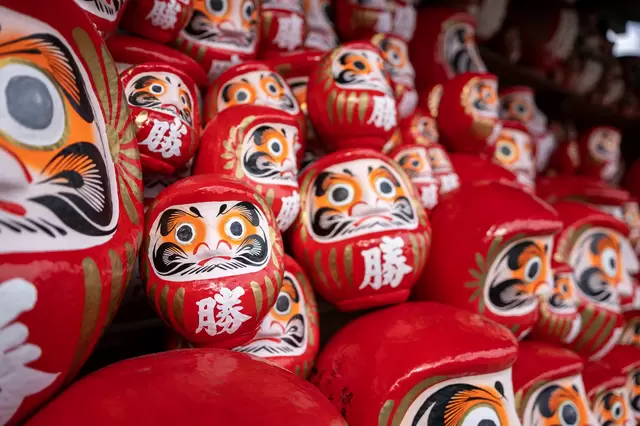Daruma - Japanese Encyclopedia

Daruma are figurines that originate from a priest doing Zazen meditation. Originally only known to followers of Zen Buddhism, the daruma has become a talisman of good luck and is enjoyable by all in Japan. Learn about the history, craftsmanship, and where to get one yourself.
What is a Daruma?

Within Zen, one of the many schools of Buddhism, the sect founder, Daruma Daishi, is a highly respected figure. At Zen Buddhist temples, hanging scrolls featuring portraits of Daruma Daishi are often displayed. In fact, this figure is often granted the same level of reverence as the Buddha himself.
It is said that Daruma Daishi as a priest had a great interest in the ascetic Buddhist practices. According to legend, Daruma Daishi spent nine years facing a wall while doing zazen meditation. He was so deep into his meditation that his arms and legs withered away. From this legend arose the image of the limbless, round figure of Daruma.
In many hanging scroll depictions of Daruma Daishi he is portrayed with a full mustache and beard, with his eyes almost invisible under thick long eyebrows. It is from these images that the version of daruma seen today has a rather wild and strong or powerful appearance.
The Meaning Behind Buying a Daruma Figure

Daruma figures today are painted red in order to protect against evil spirits. According to ancient Japanese belief, the color red (especially a vibrant red) was believed to be good luck against evil. This is why torii gates at shrines are painted vermillion, and why during lucky or auspicious events and celebrations, people often wear red clothing.
Other than being a talisman against evil spirits, daruma is believed to aid in the granting of wishes. The effect takes about one year. When first purchased, both of the daruma statue's eyes are white. While concentrating on your wish, you paint a pupil on the daruma's left eye in black ink. And, once your wish has been granted, you fill in the pupil of the right eye to indicate that enlightenment has been reached.
In Japan there are daruma for prayers for familial health, prosperity in business, successfully passing exams, and more. And now there are even daruma painted in different colors that people purchase to use in their interior decorating instead. For many who paint the eye in place and have their wish come true, they purchase a larger daruma figure the next year. By doing so, it is believed that an even bigger wish that they have will come true.
Japanese Daruma Culture

In Japan, when you successfully pass an exam or see your business improve many people hold a daruma eye-painting ceremony that they open to their friends and family in order to share their good fortune. It goes without saying that, those who have had their wish granted are happy, but when they fill in a daruma's eye (gaining enlightenment), those around them also become happier. This is because Daruma's blessing is not only for one person, but rather meant to spread out to all of those involved.
Especially large daruma, thanks to their impressive size and appearance, are often featured in the news. The chance to witness in person the enlightening of such a large daruma is done by election. Nowadays, once people have been elected to participate in this ceremony, it is not unusual to find the entire event streamed live online. Moreso than being just a family event, these ceremonies become grand performances carried out with all necessary pomp and circumstance.
Though daruma have many different uses, underlying all of them is the spirit of the Japanese. It is said that in Japan there are many people who work steadfastly towards their goals. A yearly wish equals a target for the daruma to focus on; this steady advancement towards an established goal matches the spirit of the Japanese, and has made the daruma a well-loved talisman.
Where to Find Daruma in Japan

One of the most famous temples for daruma is Heikenji Temple found in Kawasaki, Kanagawa Prefecture. The temple is popularly known as Kawasaki Daishi. Kawasaki Daishi is famous for its ability to ward off evil and disasters and is known through the expression "yakuyoke no Odaishi-sama" (divine Daishi that protects from evil). For that reason, there are many shops lining the roads leading to the temple that sell daruma statues.

The most famous area for daruma production however, is Takasaki City, in Gunma Prefecture. Shorinzandaruma-ji Temple, where the teachings of Daruma Daishi have been passed down, is located in Takasaki, and it is from this temple that the Takasaki daruma originated. All year long at the main temple building of Daruma-ji you will find a never-ending number of people coming to dedicate daruma statues. Not only that but here you can also see examples of the many different daruma statues found all across Japan.
For those who would like to see daruma in the Tokyo area, Chofu City's Jindaiji Temple is strongly recommended. Every year on March 3 and 4, this temple holds a grand festival, known as the Yakuyokeganzai Taisai Festival where you will find the Daruma Market. During this event there are over 300 market stands selling daruma of all different sizes within the grounds of Jindaiji Temple.
Being able to see this numerous different daruma as well as experiencing the atmosphere of a Japanese festival makes this event quite popular with visitors from overseas.
Read also
All pictures from PIXTA
日本への訪日外国人の方が、もっと増えますように!


































![[2026] Top 5 Strawberry Picking Spots in Tokushima, Naruto| Farms and Access Guide for January to May](https://resources.matcha-jp.com/resize/720x2000/2025/03/06-227165.webp)
![[Yamanashi/ Hokuto City] 4 Hot New Spots Opening in 2026](https://resources.matcha-jp.com/resize/720x2000/2025/12/12-252747.webp)


